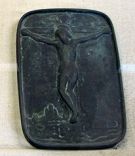
In his book Silence and Beauty: Hidden Faith Born of Suffering, artist Makoto Fujimura explains that the Japanese ideogram for “beauty” is a combination of two other symbols: one representing a sacrificial “sheep” and the other meaning “great.” This concept of beauty as “great sacrifice” not only brings insight into Japanese culture, but can also deepen our understanding of what it means to follow Christ.
Fujimura’s book is a wide-ranging reflection on Japanese culture, history, and art, and is based on another book, Silence by Shūsaku Endō. Originally published in 1966 in Japanese, Silence is becoming recognized throughout the world as a “great book,” a work of literature that conveys timeless truth. Fujimura’s exploration can further assist readers in understanding the meaning of Silence, Japanese culture, and how the story of the Japanese Christians might provide an antidote to more worldly versions of Christianity.
Silence is historical fiction based on real missionaries who followed the Biblical command to spread the Gospel to “the ends of the earth,” as Japan seemed to the Europeans. These efforts to teach Japanese about God sending his son to atone for human sin were initially successful in a culture that had already connected beauty with sacrifice. But 17th century Japanese authorities instituted a harsh and effective persecution that forced even the most dedicated believers to publicly renounce faith. This public renunciation required Christian leaders to trample on “fumi-e,” images of Christ or the Virgin.

Convicted Christians, if not martyred, were required to trample on fumi-e not just once, but at the onset of each year. The missionary priests were not permitted to leave Japan, but kept under house arrest and frequently paraded to the people as examples of the failure of Christianity.
A number of American Christians who’ve read Silence have described it as dark and depressing, and have condemned the fictional character Father Rodrigues as a failed witness. But while the book is certainly haunting, Fujimura helps readers to see that Rodrigues is much more like the Apostle Peter, and perhaps even more like Christ than we first perceive. In the modernized, Western church, we prefer more comfortable versions of Christianity. Some adhere to a politically correct and respectable church that stays relevant by keeping up with cultural trends and progressive values. Others overtly or subtly embrace forms of prosperity gospel, in which the right prayers and behavior lead to material and social success. We boast of faith heroes like Billy Graham, who led many to Christ and was popular, well-loved, and respected.
In contrast, Father Rodrigues, loses everything. Despite his prayers, God remains silent and does not spare Rodrigues from suffering. Like the Apostle Peter, Rodrigues denies Christ at the crucial moment. He becomes a despised apostate of the church and a target of ridicule for the Japanese. Even the children taunt and throw rocks at him. And yet, in a completely broken and disgraced way, he retains his faith and nurtures the faith of others.
As Fujimura explains in Silence and Beauty:
“By stepping on the fumi-e, Father Rodrigues inverts into his genuine faith, faith not dependent on his religious status or on his own merit, but a faith in grace…” (p. 147)
Fujimura asserts that Rodrigues only then really sets aside his former identity. He is no longer a Portuguese priest, but one of the broken and oppressed Japanese. (The authorities even require him to assume the name of a dead Japanese man and become husband to the dead man’s wife.) Rodrigues truly becomes one of the people he came to serve, and shares in their lives, sufferings, and temptations. Rather than attaining worldly glory,
“He was despised and rejected by men, a man of sorrows and acquainted with grief. Like one from whom men hide their faces, he was despised and we esteemed him not.” (Isaiah 53:3. ESV)
While Rodrigues and the Japanese Christians appear to have failed by worldly standards, the final pages of Silence indicate that Christian faith inexplicably survived in Japan, both for Rodrigues and for a covert group of hidden Christians. In fact, groups of Kakure Kirishitan, or “Hiding Christians,” were rediscovered by priests visiting Japan in the mid-nineteenth century. (p. 44)
Perhaps many modern American Christians do not understand Silence due to cultural and historical differences. Sometimes American Christians are like those who greeted Jesus by waving palms and cheering at his “triumphal entry” into Jerusalem, but who misunderstood his mission. They expected an earthly kingdom resplendent with glory and prosperity. But when the events of Good Friday came, they scattered and turned away. It is fitting that in the traditional Ash Wednesday observances, which emphasize confession and repentance, the ashes consist of burned palm fronds from the previous year’s Palm Sunday celebration. How appropriate to repent of those misguided Palm Sunday ambitions before entering the season that will include remembrance of Jesus’ suffering and death on a cross. As Americans, we would rather ignore Good Friday in favor of Easter, but Endō’s story presents a stark reminder of the role and reality of earthly suffering.
As Fujimura explains:
“Show me my cross” may be a statement that every Christian needs to say to the world. In chapter 16 of the Gospel of Matthew, Christ warns his followers, “If anyone would come after me, let him deny himself and take up his cross and follow me” (Matthew 16:24 ESV). For each follower to “carry his own cross” means to expect persecution, betrayals and exile from the world. The values of the “world” conflict with the key message of Christianity. (p. 46)
In Silence and Beauty, Fujimura helps us to further “translate” the lessons of Silence. He helps us to understand Endō’s message that God does speak in what seem to be silent times, places, and cultures, but we must be ready to accept that what God values is often in sharp contrast with what the world values. Living out a Christian faith requires taking up our own crosses, but suffering and sacrifice are essential to God’s beautiful plan for our sanctification and eternal joy. In this we have hope.
Postscript: While I am not typically a fan of “abstract” art, I have fallen in love with Makoto Fujimura’s paintings. There’s a lovely, short video about his work at his website, as well as more information about him, his work, and his faith. He’s also launched Fujimura Institute, which “spearheads broad initiatives that integrate art, faith, and beauty.”
